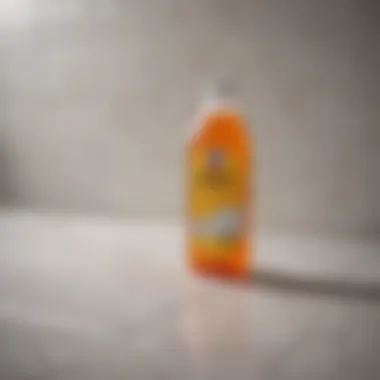Effective Methods for Cleaning Moldy Grout in Tiles: A Comprehensive Guide


Wellness
Moldy grout in tiles is not just an eyesore but also a breeding ground for harmful mold and bacteria. Cleaning it effectively is crucial for maintaining a healthy living environment. In this section, we will explore various methods and solutions to tackle moldy grout, ensuring your tiled surfaces are not only clean but also hygienic.
Understanding the Problem
Before delving into cleaning techniques, it's essential to understand why mold grows in grout. Grout is porous, making it susceptible to moisture absorption. When combined with warmth and darkness, it becomes the perfect environment for mold to thrive. By comprehending this, you can adapt your cleaning approach to address the underlying causes of mold growth.
Natural Remedies
Natural remedies offer a chemical-free approach to mold removal. Ingredients such as vinegar, baking soda, and lemon are known for their antimicrobial properties, making them effective in combating mold. We will detail step-by-step instructions on how to create and apply these natural solutions to eliminate mold from your grout without harsh chemicals.
Commercial Products
For stubborn mold or larger areas, commercial products specially formulated for grout cleaning can provide a more potent solution. From oxygen bleach cleaners to specialized grout cleaners, we will review various products available in the market, outlining their effectiveness and application methods. It's essential to choose products that not only remove mold but also prevent its regrowth.
Prevention Techniques
Once you've cleaned the moldy grout, it's crucial to implement preventive measures to inhibit mold resurgence. From ensuring proper ventilation to sealing grout lines, we will discuss practical strategies to maintain mold-free grout for the long term. By adopting these preventive techniques, you can safeguard your tiled surfaces and promote a healthy living space.
Understanding Moldy Grout
Understanding moldy grout is crucial in addressing the maintenance of tiled surfaces effectively. Mold build-up not only affects the aesthetics but also poses potential health risks. By comprehending the causes of mold growth and its implications, individuals can implement targeted cleaning strategies to mitigate these issues and maintain a hygienic living space.
Causes of Mold Build-Up
High Moisture Levels
High moisture levels serve as a fertile breeding ground for mold growth. Excess moisture can seep into porous grout, creating an ideal environment for mold spores to multiply rapidly. Understanding the propensity of high moisture levels to facilitate mold proliferation underscores the importance of addressing this fundamental cause. While moisture is essential for life, excessive levels can lead to detrimental consequences, making proactive moisture control essential in combating mold growth.
Poor Ventilation
Inadequate ventilation exacerbates mold issues by trapping moisture within enclosed spaces. Improved air circulation is pivotal in reducing moisture accumulation and preventing mold formation. Addressing poor ventilation not only enhances indoor air quality but also plays a key role in mold prevention efforts. Recognizing the significance of adequate ventilation highlights the need for ensuring proper airflow to deter mold growth effectively.
Organic Matter Accumulation
The accumulation of organic matter, such as dirt and debris, within grout lines provides sustenance for mold spores. Organic debris acts as a nutrient source, fueling mold proliferation and hampering cleaning endeavors. Understanding the role of organic matter accumulation in mold development underscores the importance of regularly cleaning grout to eliminate these organic residues. By eliminating this conducive environment, individuals can impede mold growth and preserve the cleanliness of their tiled surfaces.


Health Risks Associated with Mold
Respiratory Issues
Mold exposure can trigger respiratory issues, exacerbating conditions like asthma and causing breathing difficulties. Inhalation of mold spores can irritate the respiratory system, leading to coughing, wheezing, and other respiratory ailments. Recognizing the impact of mold on respiratory health emphasizes the need for thorough cleaning and preventive measures to safeguard respiratory well-being.
Allergies
Mold allergies are common among individuals sensitive to mold spores, manifesting as sneezing, nasal congestion, and skin irritation. Allergic reactions to mold can vary in severity, underscoring the importance of mold eradication to reduce allergen exposure. Addressing mold-related allergies necessitates comprehensive cleaning practices and vigilant maintenance to minimize allergen triggers.
Skin Irritations
Contact with moldy surfaces can cause skin irritations, including redness, itching, and rashes. Sensitivity to mold spores can result in dermatological reactions, highlighting the need for maintaining hygienic living spaces free from mold contamination. Preventing skin irritations associated with mold entails thorough cleaning regimens and proactive measures to inhibit mold growth and protect skin health.
Natural Cleaning Solutions
Cleaning moldy grout in tiles can be effectively tackled with natural solutions. Natural cleaning products offer a safer and eco-friendly alternative to harsh chemicals, maintaining a healthy environment. Vinegar and baking soda stand out as prominent natural remedies for grout cleaning, harnessing the power of these household items to combat mold and mildew.
Vinegar and Baking Soda
Preparation and Application
preparation and application of vinegar and baking soda play a fundamental role in the cleaning process. By creating a paste with these two ingredients and applying it to the affected grout lines, the natural acidity of vinegar combined with the abrasiveness of baking soda works to dissolve mold and lift stains effectively. This method is not only cost-effective but also environmentally friendly, making it a popular choice for individuals seeking natural cleaning solutions.
Effectiveness and Safety
When considering effectiveness and safety, vinegar and baking soda excel as a duo in mold removal. The natural properties of these ingredients work synergistically to kill mold spores and prevent regrowth. Additionally, they pose no threat to your health or the surrounding environment, ensuring a safe cleaning experience. While this method may require a bit more elbow grease compared to commercial cleaners, the results are impressive and long-lasting.
Lemon Juice and Salt
Application Techniques
The application techniques involving lemon juice and salt offer a citrusy and abrasive solution to moldy grout. Lemon juice's acidic nature aids in breaking down mold while salt acts as a mild abrasive to scrub away stubborn stains. By mixing these two ingredients into a paste and applying it to the grout, you can effectively target and eliminate mold buildup without harsh chemicals. This technique is gentle yet potent in restoring the cleanliness of grout lines.
Results and Benefits
Utilizing lemon juice and salt for grout cleaning provides not only a fresh scent but also antibacterial properties that help disinfect the treated areas. The natural bleaching effect of lemon juice can lighten stains, while salt aids in scrubbing away grime. This method proves to be a great alternative for those looking to steer clear of chemical-laden cleaners, offering a natural and efficient way to maintain clean and mold-free grout.
Commercial Cleaners


Commercial cleaners play a crucial role in the process of dealing with moldy grout in tiles. These cleaners are specifically formulated to tackle tough mold and mildew stains that may be resistant to natural cleaning solutions. Their effectiveness in breaking down mold and mildew spores makes them a valuable asset in restoring the cleanliness of grout lines. Unlike homemade remedies, commercial cleaners often contain potent ingredients that can eradicate mold infestations efficiently.
When considering commercial cleaners for moldy grout, it is essential to carefully follow the product's usage instructions to achieve optimal results. These instructions typically outline the dilution ratios, application methods, and recommended safety precautions. Following the correct usage instructions helps ensure that the cleaner works effectively without causing damage to the tiles or grout.
In addition to effective cleaning, safety precautions associated with commercial cleaners are paramount. Many commercial products contain strong chemicals that can be harmful if not handled properly. It is crucial to wear protective gear such as gloves and masks when using these cleaners to avoid skin irritation or respiratory issues. Proper ventilation during application is also recommended to minimize exposure to fumes.
Bleach-Based Products
Usage Instructions
The usage instructions for bleach-based products are essential for achieving successful mold removal in grout lines. These instructions usually involve diluting the bleach with water in specific ratios to create a cleaning solution. The bleach solution is then applied directly to the moldy grout using a spray bottle or sponge, allowing it to sit for a designated period to penetrate and kill the mold spores effectively.
One of the key characteristics of using bleach-based products is their potent disinfectant properties. Bleach is known for its ability to kill mold on contact, making it a popular choice for mold remediation. The unique feature of bleach-based products lies in their fast-acting nature, providing quick results in eliminating mold stains and odors from grout surfaces.
While bleach-based products are highly effective in mold removal, they come with certain disadvantages. Bleach fumes can be strong and irritating, requiring adequate ventilation during application. Moreover, bleach may cause discoloration or damage to certain types of tiles or surfaces if not used correctly.
Safety Precautions
When using bleach-based products for cleaning moldy grout, observing safety precautions is crucial to prevent accidents or health risks. It is vital to wear protective gear such as gloves and goggles when handling bleach to avoid skin and eye irritation. Additionally, working in a well-ventilated area helps disperse bleach fumes and reduces inhalation risks.
One of the key characteristics of safety precautions for bleach-based products is the emphasis on avoiding contact with skin or eyes. In case of accidental contact, it is recommended to rinse the affected area thoroughly with water and seek medical advice if irritation persists. Proper storage of bleach away from children and pets is also advised to prevent accidental ingestion.
Tile and Grout Cleaners
Types of Products
Tile and grout cleaners come in various formulations designed to target specific types of stains and grime on tiled surfaces. These products range from acidic cleaners for tough mineral deposits to enzymatic cleaners that break down organic matter. Choosing the right type of cleaner depends on the nature of the grout discoloration and the material of the tiles.
One of the key characteristics of tile and grout cleaners is their versatility in addressing different types of stains. Whether it's grease, soap scum, or mold, there is a suitable cleaner available to tackle the specific issue. The unique feature of these cleaners is their ability to penetrate porous grout and lift embedded dirt for thorough cleaning.
While tile and grout cleaners offer convenience and efficiency, some products may contain harsh chemicals that require careful handling. Users should read the product labels carefully and follow the recommended application tips to ensure safe and effective cleaning. Proper ventilation and wearing protective gear during use are recommended precautions to prevent exposure to potentially harmful ingredients.
Preventive Measures
Preventive measures play a crucial role in maintaining clean grout and ensuring the longevity of tiled surfaces. By implementing preventive strategies, individuals can mitigate mold growth, ultimately fostering a healthier living environment. Regular upkeep and proactive measures are essential in preventing mold accumulation and preserving the integrity of grout lines. In this section, we will delve into the significance of preventive measures, outlining their benefits and key considerations for effective mold prevention.
Sealing Grout Lines


Benefits of Sealing
Sealing grout lines offers a protective barrier against moisture and mold infiltration, enhancing the durability of tiled surfaces. The primary benefit of sealing lies in its ability to repel water and stains, prolonging the lifespan of grout while maintaining its aesthetic appeal. Additionally, sealed grout lines resist mold and mildew growth, promoting a hygienic environment. The cost-effective nature of sealing treatments makes them a popular choice for individuals seeking long-term grout protection. Despite its advantages, proper application is necessary to ensure optimal performance and durability.
Application Guidelines
When applying grout sealant, thorough cleaning and drying of grout lines are imperative to maximize adhesion and effectiveness. Selecting a high-quality sealant suitable for the specific tile material is crucial for achieving desired results. Even coverage and sufficient drying time are key considerations during the application process. While sealing provides numerous benefits, it is essential to follow manufacturer guidelines and reseal grout lines periodically to maintain their protective properties.
Ventilation and Humidity Control
Importance of Air Circulation
Effective ventilation plays a vital role in preventing excess moisture buildup, which is conducive to mold growth. Proper air circulation aids in regulating humidity levels, making it challenging for mold spores to thrive. Good ventilation promotes a healthier indoor environment by reducing the risk of mold-related health issues. Incorporating ventilation systems and opening windows are practical ways to improve air circulation and minimize mold proliferation.
Humidity Monitoring Tips
Regular monitoring of indoor humidity levels is essential for mold prevention. Utilizing hygrometers or humidity sensors can help individuals keep track of humidity fluctuations, enabling timely intervention to maintain an optimal indoor climate. Maintaining indoor humidity below 60% is recommended to discourage mold growth. Additionally, implementing dehumidifiers in moisture-prone areas can assist in controlling humidity levels and preventing mold infestation.
Professional Cleaning Services
Professional cleaning services play a crucial role in maintaining the cleanliness and hygiene of tiled surfaces. When embarking on the journey to clean moldy grout in tiles, enlisting the help of professional cleaners can provide a level of expertise and efficiency that may be challenging to achieve through DIY methods alone. These services offer a comprehensive approach to tackling mold and grime buildup, utilizing specialized equipment and solutions to ensure a thorough cleaning process.
Hiring Professional Cleaners
Benefits and Considerations
Professional cleaning services come with a multitude of benefits and considerations that make them an indispensable resource in the quest for pristine tile surfaces. The expertise and experience of trained professionals guarantee a higher quality of cleaning compared to conventional methods. Moreover, these services often use eco-friendly and effective cleaning agents, minimizing the use of harsh chemicals while maximizing results. Additionally, outsourcing the cleaning to professionals frees up time and energy for individuals, allowing them to focus on other aspects of life.
Finding Reliable Services
Finding reliable cleaning services is paramount to the success of the cleaning endeavor. It is essential to choose a service provider with a proven track record of delivering exceptional results. Look for testimonials and reviews from previous clients to gauge the quality of service offered. Additionally, consider factors such as pricing, service guarantees, and the range of cleaning techniques employed. Opting for a reputable and trustworthy cleaning service ensures a seamless and satisfactory cleaning experience, ultimately contributing to the longevity and aesthetics of tiled surfaces.
Maintaining Clean Grout
Maintaining clean grout is a crucial aspect of preserving the longevity and aesthetics of tiled surfaces. Clean grout not only enhances the overall appearance of a room but also contributes to a healthier living environment by eliminating mold and bacteria buildup. By following a regular maintenance routine, homeowners can prevent the need for extensive cleaning or repair work in the future. Additionally, clean grout provides a sense of cleanliness and hygiene that is essential for a comfortable living space. Prioritizing the upkeep of grout lines ensures that the tiles remain in optimal condition, avoiding costly replacements or restorations.
Regular Cleaning Routine
Frequency Recommendations
Frequency recommendations for grout cleaning play a pivotal role in ensuring the sustained cleanliness and durability of tiled surfaces. Establishing a consistent cleaning schedule, such as weekly or bi-weekly grout maintenance, aids in preventing mold and mildew growth. By regularly removing debris and surface stains, homeowners can maintain the pristine appearance of their tiles and grout. The recommended frequency of cleaning ultimately depends on the level of foot traffic and exposure to moisture in the tiled area. Adhering to these frequency guidelines not only enhances the aesthetic appeal of the tiles but also extends their lifespan, promoting long-term cost-efficiency.
Effective Cleaning Practices
Effective cleaning practices are essential for achieving optimal results in grout maintenance. Utilizing appropriate cleaning solutions and tools, such as gentle brushes and microfiber cloths, facilitates the removal of dirt and grime from grout lines without causing damage to the tile surface. Employing techniques like scrubbing in circular motions and allowing sufficient dwell time for cleaning agents to loosen debris enhances the efficacy of the cleaning process. Additionally, incorporating natural cleaners like vinegar or baking soda can provide a safe and eco-friendly alternative to chemical products, minimizing the risk of harmful fumes or residues. By adopting effective cleaning practices, homeowners can ensure the thorough cleanliness of grout lines while preserving the integrity of their tiled surfaces.



